Perhaps the most confusing of all mouthpiece conundrums is the problem of balancing the resistance between the player and his equipment set up.
At least once a day I get a call from a player complaining about a feeling of tightness in the mouthpiece. A feeling that one can’t get enough air into the mouthpiece, especially when ascending into the upper register, even to the point of feeling choked. The most natural reaction to this feeling, and the common wisdom in solving the problem, has been to open things up. Open the bore, deepen the cup, open the back bore, do all three together! However, in 95% of these cases, in spite of how counterintuitive it seems, the answer lies in tightening something down.
The feeling of tightness or resistance is often a sign that there is already too much internal volume in the set up, or not enough resistance. What the player is feeling, in reality, is that they are no longer able to move the air to velocity. I often ask players to imagine trying use their breath to move the air quickly in a tube 1 foot long and about 5 inches across. Compare this with the thought of trying to create velocity in a tube 3 inches long and the width of something about the size of a cigar. If you actually try this experiment, you will see that the speed of the air coming out of the end of the large tube is practically nil, while the smaller tube will show some impressive force. Same player… significantly contrasting results.
Successful brass playing is all about the ability to create the velocity of air needed to play loud and high with maximum efficiency. When the equipment set up is balanced to a personal best ‘point of velocity’ for a given player, they are in control of how fast the air is moving and how fast and accurately notes will slot.
Benefits of a Balanced Set Up
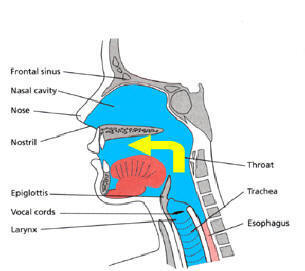 A balanced set up is one in which the player is able to maintain a relaxed and open position in terms of the oral cavity. (see fig. A )
A balanced set up is one in which the player is able to maintain a relaxed and open position in terms of the oral cavity. (see fig. A )
In figure A the tongue is in a relaxed, natural position. The back of the tongue is down, resting between the bottom teeth. In this position the amount of air that can be fed directly to the front of the mouth is at it’s greatest. Maximizing the oral cavity is the underpinning of a magnificently large sound. The oral cavity, just as any singer will tell you, is the echo chamber for tone. I have worked with countless players who have been using mouthpieces, coupled with equipment, that have a collective internal volume that is far greater than what they are capable of handling. They think that large equipment means a large sound. In practice, the excessive volume is causing them to crush down their oral cavity. The body instinctively tries to create the resistance that is not present in the equipment. It literally tries to create a smaller tube to blow through in an attempt to speed the air.
Tools for Controlling the Speed of the Air
A brass player has three physical tools to control the flow of the air: the vocal cords, the aperture of the lips and the position of the tongue.
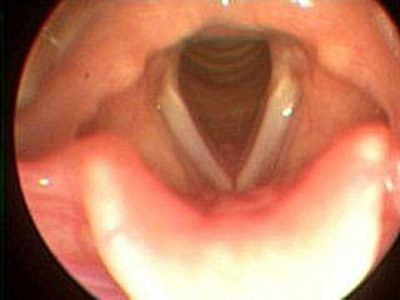 The vocal cords ( see fig. B ) can be relaxed or contracted which varies the air pressure through the glottis.
The vocal cords ( see fig. B ) can be relaxed or contracted which varies the air pressure through the glottis.
The pitch of our voice is adjusted in this way, tuning higher or lower. In the same way, using the vocal chords helps to regulate the flow of the air in brass playing. Flexing the chords closes down the air passage, compressing and speeding the air. Relaxing the chords slows the air. Players will often make use of syllables to facilitate the control of the chords. Syllables such as “EE”, close the chords speeding the air. The use of syllables like “ooh” or “ahh” are meant to encourage the chords to relax opening the air passage and slowing the air.
Being strapped with excessive internal volume makes getting into the upper register that much more difficult. The player will have already “gone to the whip” in closing down the air in terms of the physical tools available to him and still not have been able to reach the needed velocity. It’s simple physics. The important thing to keep in mind is that the equation is different for every individual. Nuances in the structure of the oral cavity (high palate, low palate) tongue thickness, teeth size, overall head structure all contribute to how much oral volume a given individual works with. This is why successful players can and do legitimately claim to use varying techniques to accomplish the same ends.
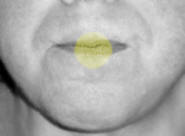
The Aperture
The aperture functions in the same manner. Players who have apertures that are more open than they should be are constantly in the position of trying to create velocity over too great an area. These players are usually either playing on the wrong inner diameter size, or have been taught that if they play with an open aperture they will have a dark sound. This is too true. The sound is dark because with the aperture set open, not enough velocity can be created to brighten the sound.
Players in this situation are in the same boat as those that are using equipment with an internal volume that is too great for them. When there isn’t enough resistance present in the set up, the body steps in to take control by trying to regulate the flow of the air. This is done in two different ways. The first of which most brass players have some experience with. That would be closing the chords and/or throat.. How many of you have been told that you need to learn to relax your throat? How successful have you been? This is because your body reacts instinctively to do what it knows it needs to be done…shut things down. Trying to relax the throat while keeping the balance of resistance in your set up exactly the same, is a hopeless endeavor. The body instinctively does what it needs to do to try to control the flow of the air. When the balance in resistance is right, the player can maintain a relaxed position longer, ascending into the upper register long before the chords and throat stop the flow of air.
Tongue Position
Less often recognized as a factor, the tongue also throws itself with gusto into the breach. Closing the chords and tightening the throat draws quick attention to itself because of the discomfort and pain it can cause. However, the tongue’s seemingly endless flexibility to move in every possible direction, assume a wide variety of shapes and go from a soft, relaxed mass to a more rigid form allows it to often go completely unnoticed…and unchecked. When things are out of balance the tongue can wield maniacal power over the flow of air. Most players have no clue as to what their tongue is doing or why it is doing it. Even players who understand intellectually what the tongue should be doing, seldom recognize that their tongue has seized the dominant role in controlling the air flow by raising up in the back of their mouth and drastically reducing the amount and velocity of air that reaches the front of the mouth. (see fig. B) Figure “C” shows what happens to the tongue when a player is using equipment without enough resistance to match their needs, or a player who is playing with their aperture set too far open. The tongue rises in the back of the mouth and can often be heard to be butting up against the soft palate. When this happens the sound will go from being vibrant and clear to having a clouded or veiled quality. The pitch will also flatten off as the amount of air being fed to the vibrating lips is reduced. Without a constant and strong flow of air going to the embouchure, the lips tire much more quickly. Teachers and students alike are obsessively focused on the intake of air.
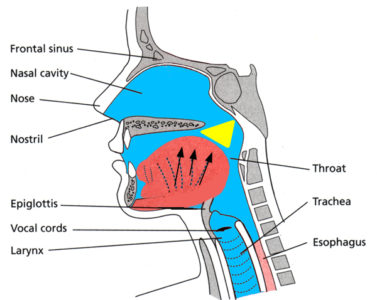
Fig. C Tongue up in back. The air flow (yellow arrow) is constricted.
How many are as aware of the quantity and speed of the air that actually makes its way out? I have witnessed, countless times, the disconnect that exists for the player who is struggling with the upper register and hasn’t grasped the fact that there is no air getting to the front of his mouth because the body has locked it down in the back of the throat. Nothing is coming out in terms of sound, because nothing is coming out in terms of air!!!
Two Possible Scenarios
If the player was putting copious amounts of air through the instrument, as they always believe they are, not being able to play high notes would sound like a rush of air, but without a note sounding. This has commonly become known as playing an “air ball”. The reason for this phenomenon is all too obvious. The lips are simply not close enough together to vibrate. However, in most cases, the opposite happens.
The air slows continually as the player ascends in range, until things simply shut down. The attuned ear can hear this happen quite clearly and long before it’s ill effects take a stranglehold (literally!) The sound can be heard to be directed away from the front of the mouth and get stuck in the back of the throat. The tone will go from having a fundamental “ooh” or “ahh” characteristic to more of an “ehh” or ‘ihh” quality. Players most often want to blame this effect on there being too much resistance present, but my experience with thousands of players shows the opposite to be true. As I have said, in at least 95% of all cases when the player is offered a mouthpiece that has a tighter overall volume than the one he is currently using, he will immediately exclaim, “Wow, that opens right up!”
Exceptions
Of course, there are the remaining ten percent who actually benefit from opening things up or adding to the overall volume of the equipment set up. These are the exceptions rather than the rule. There are 2 cases where the player may legitimately look to add onto the volume of their current set up. The most reliable indicator is the pitch in the upper register. If a player has no apparent embouchure flaws and plays comfortably into the upper register, but the intonation flattens off, in spite of the tone being clear and open, and with no audible drop in the speed of the air, the chances are that not enough air is moving fast enough and that the bore of the mouthpiece needs to be opened.
Case number two is the player who feels that no matter how hard they are blowing, they just do not get enough volume (decibels). This is a situation that will absolutely be corrected by going to a larger set up. In both cases, the verifiable evidence that going larger was the right thing to do is that the tone will brighten. This means that the air is moving faster! This is also the reason that certain players, going to a larger back bore, that has been described as offering a “Dark, Symphonic Sound” will actually experience a brightening in their sound. They are able to put more air through faster in a larger space. The larger area did not slow the air for them (producing a darker sound). Instead, the greater volume released the air, quickening the velocity and brightening the sound.
The Rehabilitation Process…or Back from the Brink!
The biggest problem I face when attempting to rehabilitate a player who has fallen prey to continually adding to the internal volume of their equipment is that a change to the mouthpiece alone is not enough. The maxim that “the mouthpiece forms the player” is too true for good and for bad. In the case of the player who has been working with equipment that does not offer him enough resistance, the poor and counter productive habits that he has “reped” into the body over many years of practice must be dealt with, not only with new equipment that will shift the balance of the resistance, but also with new and powerful concepts that will allow him to use his internal mechanisms in a proper and constructive manner. The old playing techniques will not work on more efficient equipment. In fact, as we have shown, the old playing techniques have been working their way towards undermining solid performance foundations over time. The “short term fix’ that the player experienced every time he went larger was simply allowing him to get away with increasingly counter productive habits. Long term he has no where left to go because the tongue and chords are so completely crushed down that he has very little left in terms of usable register in which to play. The upper register has collapsed as has the bottom register. In the upper register it is painfully obvious that there is no air coming out. No velocity, no vibration, no sound, no range! In the bottom range the tongue has become so accustomed to being placed so high up that it acts as a kind of bulwark in stopping the flow of air. If you ask this player to play any low note loudly, the problem is magnified to a ridiculous extreme. Nothing will come out! They are often extremely proud of themselves, thinking that their inability to get even low notes from a tighter mouthpiece demonstrates what “hard core animals” they are. The problem with this thinking is that the players who are doing the loudest and highest playing with the most extreme endurance rarely use anything near what these poor victims have been lead into using.
Doing the Work
Retraining the tongue to funnel the air towards the front of the mouth can be a difficult process. For players who have large, beautiful tones, but experience difficulty going into the upper register, the solution can be as simple as correcting any wild imbalances and misfits in terms of the inner diameter they may present in their equipment and then introducing them to more positive air flow techniques. Raising the tongue in the front of the mouth acts to compress the air, creating the velocity to vibrate the lip and go easily into the upper register. The player with a good sound simply needs to use the new technique to extend that sound into the upper register.
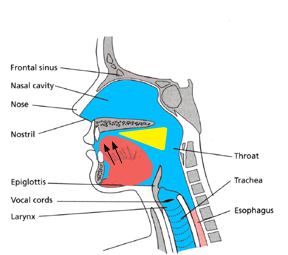
Fig. C The tongue bring raised in the front of the mouth
I have seen many a player who knows, intellectually, that this is the way that they should be playing, but because they have been using a mouthpiece with an overall internal volume that was too great for them to manipulate, just going through these motions yielded no results at all for them. They may have already spent years in the struggle between the tongue moving back on them without the ability to gain control over it. Without ever having the experience of how it feels when things work properly, they have no way to practice proper technique. Instead, they have to believe that what they are doing is all there is. “Bumping” these players into the experience of how easy it can be to accelerate the air in an efficient manner is one of the most gratifying aspects of the work I do.
On the other hand are those players who, because they have had to crush down the inside of their mouth so severely all the time, have never really produced a full and vibrant tone in their entire playing life. They have never actually heard the natural ring of the instrument. When this is the case, the player loses out on having one of the most valuable tools any brass player can have in trying to master the instrument. Staying in the center of a resonant, full sound is the most self correcting mechanism and very best teacher a player can have. The player with a “crushed sound” has no natural pitch center of the instrument to help guide them. Instead, every other note is twisted and manipulated to the point where what comes out is usually some curious affectation of what the instrument should sound like. In these cases, problems are greatly magnified as one first needs to take the player through the steps that will allow them, for the first time, to hear and feel what proper tone production is like. In these cases, just getting the player to recognize the feeling and the sound enough to know where to go back to is a major “bump.” All this can be pretty tough work, but the satisfaction of seeing a player performing with ease and comfort for the first time in their lives is fair compensation. They never knew it was supposed to be fun!
Fine Tuning
For the player who has consistent tone production and is adept at properly manipulating the air, the various elements of the mouthpiece can be tweaked to either speed or slow the air to produce different qualities in sound and response. Everyone works with compromises between efficiency and artistic goals in sound production. How far one can go towards darkening the sound should be restricted by how well one is able to balance the other aspects of fine playing, (ie., attack, tone color, ability to play long phrases, intonation, response) not just treated as an end unto itself that throws every other aspect over board to gain supremacy. Likewise, players with especially brittle, edgy or small, bright sounds usually can afford to take on a bit more in terms of volume to help ease some of these undesirable characteristics. Intelligent use of integral equipment…what a concept!